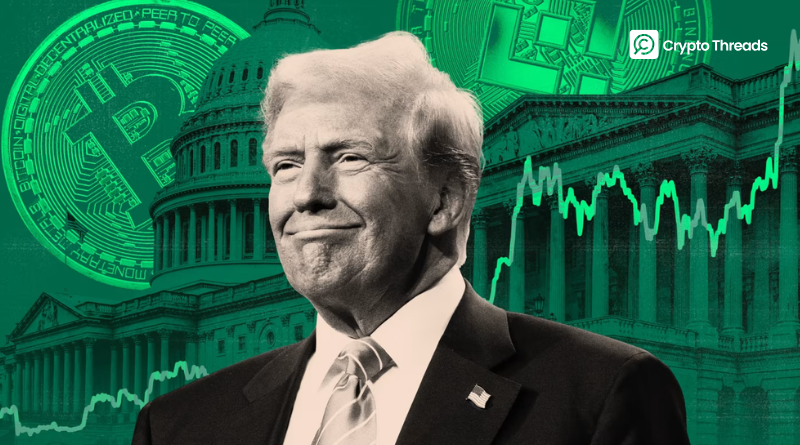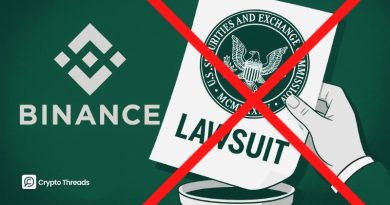Trump’s First 6 Months In Office: Progress or Broken Promises?
Key Takeaways
- Firing Gary Gensler: Completed – Former SEC Chairman has departed and strict DeFi regulations have been withdrawn
- Strategic Bitcoin Reserve: Partially Completed – Legal framework established but no new purchases made
- Ending “Operation Chokepoint 2.0” and Banning CBDC: Significant Progress – GENIUS Act signed, anti-CBDC bill awaiting Senate
- Global Crypto Capital: Not Completed – Still facing many challenges regarding liquidity and trade policies
Background and Initial Commitments
In 2024, Donald Trump positioned himself as a political outlier who was willing to embrace crypto at a time when the industry felt cornered. His presence at the Bitcoin Conference in Nashville was more than a headline; it was a calculated message. With approximately one-fifth of the American population involved in crypto in some capacity, Trump identified a growing, tech-savvy voter base disillusioned by regulatory clampdowns. He pledged to rebuild trust between Washington and the crypto community through a sweeping crypto policy framework.
Trump’s crypto platform centered on four key goals: remove adversarial regulators, establish a national Bitcoin reserve, end systemic discrimination against crypto firms in banking, and elevate the U.S. to global leadership in digital assets. These promises excited both retail and institutional actors in the crypto ecosystem. However, as with any administration, the real test lies in sustained policy implementation rather than campaign rhetoric.
Six months into his second term, the crypto industry has seen dramatic shifts, but also frustrating plateaus. This report breaks down each of Trump’s four core commitments and evaluates the extent to which his administration has followed through not just in executive action, but in creating structural change.
First Commitment: Gary Gensler’s Departure
Progress: Completed
Trump began with a direct move: removing SEC Chairman Gary Gensler on January 21, 2025. Known for his confrontational enforcement strategy, Gensler was seen as a barrier to crypto innovation. His departure was swiftly followed by the withdrawal of several SEC proposals, including revisions to Rule 3b-16 that would have broadened the definition of securities exchanges to include DeFi protocols. The rollback suggested a shift in tone, if not yet a full transformation of institutional posture.
Investigation into Gensler’s Spending
In March, Coinbase launched an investigation into Gary Gensler’s spending on crypto enforcement actions through Freedom of Information Act (FOIA) requests. However, as of July 31, 2025, the SEC has not yet responded to this request.
This FOIA investigation is not merely an information-seeking move but also demonstrates the crypto industry’s clever “counter-attack” strategy. Coinbase’s 17-point request, filed March 3, 2025, demands the SEC disclose details about the number and costs of lawsuits, employee participation, costs for external contractors, and specifically the budget of the “Crypto Assets and Cyber Unit” – the notorious unit that initiated over 100 lawsuits against crypto companies.
Paul Grewal, Coinbase’s Chief Legal Officer, cleverly framed this issue not as “revenge” but as “taxpayer accountability.” He emphasized: “We know the SEC’s previous ‘regulation by enforcement’ approach has cost Americans innovation, global leadership, and jobs, but how many taxpayer dollars did it cost?”
The SEC’s prolonged silence in responding to this FOIA has become a powerful propaganda weapon for the crypto industry. Each day of delay further reinforces the image of an agency lacking transparency, especially in the context of lawsuits being withdrawn en masse under new leadership. Tyler Winklevoss of Gemini even called Gensler “evil” and called for boycotting any company that hires him after leaving the SEC.
Strategically, this investigation serves two purposes: creating political pressure to prevent the return of hardline policies in the future, and providing actual data for Congress to evaluate the effectiveness of public spending. Coinbase’s willingness to wait “through the entire FOIA process” shows determination to turn this into a long-term campaign aimed at changing how regulatory agencies operate.
Second Commitment: Establishing Strategic Bitcoin Reserve
Progress: Completed in Phases
Trump committed: “The United States will retain 100% of all Bitcoin currently held or acquired in the future” and “ensure the United States becomes the global crypto capital and Bitcoin superpower of the world.”
In early March, Trump signed an executive order establishing two digital asset storage mechanisms:
1. Strategic Bitcoin Reserve (BTC)
- Initial funding: Approximately 200,000 bitcoins acquired by the government through criminal and civil forfeitures
- Special authority: Treasury Secretary and Commerce Secretary authorized to seek ways to acquire more Bitcoin without increasing taxpayer burden
- Positioning: Bitcoin considered a national digital store of value
2. Other Digital Asset Reserve
- Includes: XRP, ADA, ETH, SOL and other assets besides Bitcoin
- Principle: Government will only seek budget-neutral measures and not proactively increase holdings of other digital assets
- Transparency: Requires comprehensive auditing of all existing digital assets
Market Reaction
This decision created notable mixed reactions. Despite expectations it would boost Bitcoin prices, the market reacted negatively with Bitcoin dropping up to 6% immediately after the executive order was signed. The main reason was that the order “did not create additional market demand that many expected” because no new purchase plans were announced.
David Sacks had to clarify that this reserve would be funded entirely by bitcoin seized in criminal and civil cases, ensuring taxpayers would not bear the financial burden. However, this also means the government would not buy additional new Bitcoin, disappointing many investors.
One of the biggest controversies centers around Trump’s decision to include multiple cryptocurrencies rather than focusing solely on Bitcoin. Brian Armstrong, CEO of Coinbase, expressed his view: “Bitcoin-only would probably be the best choice – simplest and clear story as gold’s successor.” Gabor Gurbacs also criticized: “So the US will use taxpayer money for XRP, SOL and ADA? Why build a strategic reserve for something you can print?”
From an economic perspective, Cornell professor Eswar Prasad warned that this reserve could put the federal government in a difficult position when it becomes a major player in the crypto market with significant influence on prices. He argued that “the government would essentially be locked into these holdings” because liquidation could cause price collapse.
Maxine Waters, Democratic House Financial Services Committee member, criticized this proposal as “foolish” and declared that crypto is not “essential input driving the US economy and daily lives of American families” – commonly seen in government strategic reserves.
Experts question Bitcoin’s essentiality compared to traditional strategic reserves like oil, gold, medical equipment. Stephen Cecchetti argued: “Strategic reserves are for essentials, either for national defense or economic security. What exactly about Bitcoin is essential in our lives that the United States would want a reserve?”
The BITCOIN Act was reintroduced by Senator Cynthia Lummis in March with co-sponsorship from 5 other senators, proposing to buy 1 million Bitcoin over 5 years – equivalent to about 5% of total Bitcoin supply and worth approximately $88 billion. Bo Hines, Executive Director of the Presidential Council on Digital Assets, even proposed selling part of America’s gold reserves to buy more Bitcoin.
Despite controversies, removing over $17 billion in selling pressure from the market is considered positive, and some states like Oklahoma, Utah and Arizona have proceeded with similar Bitcoin reserve proposals. This shows the spreading trend of government-level Bitcoin reserve ideas, though many questions remain about long-term feasibility and effectiveness.
Third Commitment: Ending “Operation Chokepoint 2.0,” Banning CBDC and Stablecoin Regulation
Progress: Significant Progress
Trump declared: “As president, end ‘Operation Chokepoint 2.0’ immediately” and “When I am President of the United States, there will never be a central bank digital currency.”
Progress Achieved:
Personnel:
- Appointed David Sacks as White House AI and crypto director
Legal:
- Anti-CBDC Act (S.1124): Passed the House, Anti-CBDC Act expected to be considered by Senate after August recess
- GENIUS Act: The GENIUS Act, or National Innovation and Establishment Guidance Act for stablecoins, was signed by President Donald Trump on July 18
Stablecoin Legal Framework:
- Requires stablecoins to be 100% backed by US dollars or equivalent liquid assets
- Annual audits for issuers with market caps over $50 billion
- Establishes regulatory guidance for overseas issuance
This commitment represents the most complex aspect of Trump’s crypto agenda, requiring synchronized coordination across multiple fronts from personnel, legislation to enforcement. Trump has applied a clever “divide and conquer” strategy, separating three related but independent issues to increase success chances.
In terms of personnel, appointing David Sacks as a “super czar” has proven Trump’s strategic vision. Sacks not only brings credibility from Silicon Valley but also serves as an important bridge with the crypto community. The decision to give someone who understands both technology and has investment experience and political relationships shows Trump learned from first-term mistakes in personnel selection.
On the legislative front, Trump has shown political savvy by separating the anti-CBDC bill – an issue with broad bipartisan consensus due to concerns about privacy and government control. This bill’s smooth passage through the House proves Trump’s accurate calculation of American political psychology. Meanwhile, keeping the GENIUS Act on stablecoins separate allows focus on complex technical details without being drawn into CBDC controversy.
However, the biggest challenge remains “Operation Chokepoint 2.0” – an issue requiring not just policy changes but cultural change in banking. JPMorgan’s continued “strangling” of Gemini shows traditional financial corporations haven’t truly changed attitudes. This reflects a harsh reality: while Trump can change government policy quickly, changing private sector behavior requires time and stronger measures.
Overall, Trump has completed about 60% of this commitment. All tactical steps are in the right direction, but final implementation still depends on the ability to overcome resistance from interest groups within the current financial system.
Despite progress, there’s still evidence of “financial crackdown” on cryptocurrency platforms from the US banking industry, such as the situation between Gemini and JPMorgan.
Fourth Commitment: Global Crypto Capital and Bitcoin Superpower
Progress: Not Completed
This is Trump’s most important promise and also his biggest challenge. Currently, the road ahead is still very long.
Current Challenges:
Trump’s goal of establishing the United States as the global crypto capital has encountered more obstacles than progress. Although a digital asset strategy was introduced in July, few practical measures have followed. Core instruments such as tax incentives, infrastructure investment, and international digital finance partnerships remain underdeveloped. The policy framework, while ambitious on paper, has yet to translate into meaningful institutional engagement or global positioning.
One persistent challenge is the Federal Reserve’s continued resistance to lowering interest rates. Elevated rates suppress risk appetite and limit capital available for crypto markets, particularly in the venture and retail investment space. As long as borrowing remains expensive and liquidity constrained, the environment for crypto innovation will remain tepid regardless of political rhetoric. This monetary stance has made it difficult for any administration to catalyze a wave of digital asset adoption or development.
Trade dynamics further complicate matters. The Trump administration’s decision to reinstate and expand tariffs has created an unpredictable economic climate. Frequent shifts in policy and retaliatory responses from global partners have dissuaded institutional investors from deepening exposure to U.S.-based crypto ventures. For capital allocators navigating cross-border flows, regulatory volatility represents an unacceptable risk. As a result, some venture capital and Web3 infrastructure firms have slowed or rerouted their U.S. expansion plans.
Trump’s Relationships with Influential Crypto Figures
In addition to policy hurdles, Trump’s deteriorated relationship with Elon Musk has damaged the perception of a unified tech-government alliance. Musk, once a public supporter of the administration’s crypto stance, has since become a vocal critic, especially after disagreements over regulatory approaches and broader political tactics. Their feud quickly turned personal, culminating in public accusations and retaliatory threats. The crypto markets responded swiftly, with Bitcoin and Dogecoin suffering immediate declines, reflecting investor anxiety over fractured leadership.
David Sacks – Key Figure in the Crypto Ecosystem
In the context of Musk’s departure, David Sacks has emerged as the most important figure in shaping Trump’s crypto policy. As “AI & Crypto Czar,” Sacks – a member of the “PayPal Mafia” along with Musk and Peter Thiel – has become the main bridge between Silicon Valley and the White House.
Sacks played an important role in convincing Trump to support crypto through a $50,000/ticket fundraising dinner at his San Francisco home, where crypto executives presented on the “crackdown” from the Biden administration. Currently, he is leading legislative efforts on stablecoins and evaluating the feasibility of implementing strategic Bitcoin reserves.
Influence Network in Trump Administration
The Trump administration has an unprecedented proportion of crypto-holding officials – over 1/5 of senior candidates report investments in digital assets, with a minimum total value of $193 million. Vice President JD Vance and 7 cabinet members have also disclosed crypto investments. Notably, Ken Howery, candidate for Ambassador to Denmark and PayPal co-founder, holds at least $122 million in digital assets.
Other influential figures:
- Peter Thiel: Vance advisor and powerful influencer in tech policy
- Paul Atkins: Nominated as new SEC Chairman, strong crypto supporter
- Michael Kratsios: Former CTO of first Trump administration, now overseeing tech policies
- Emil Michael: Former Uber executive, appointed to senior Pentagon position
Despite ideological tensions in the tech-MAGA alliance, its profit-driven nature has overcome these differences. Many tech figures still choose silence and support Trump for business interests, even after Musk’s departure. Circle’s success in stock listing and multi-billion dollar government contracts with Thiel’s Palantir have proven this alliance still has great economic value.
Evaluation Framework
Assessing whether Trump has fulfilled his promise to make the United States the global capital of crypto requires a clear set of criteria. One-time declarations or symbolic actions are not sufficient; measurable, systemic progress is necessary. Based on the current trajectory, three key indicators provide a grounded framework for evaluation.
First is whether the federal government has initiated direct Bitcoin purchases under its name. Holding previously seized BTC is a passive strategy. To show true conviction, the government would need to participate in active accumulation, signaling confidence in Bitcoin as a long-term sovereign asset. Such action would not only remove supply from circulation but would also position the U.S. as a monetary innovator in competition with traditional central banks.
Second is whether major publicly traded U.S. companies have begun adding crypto, particularly Bitcoin, to their corporate treasuries at scale. When the private sector mirrors federal policy, it reflects deeper institutional confidence. If a meaningful percentage of S&P 500 firms start reporting digital assets on balance sheets, it would confirm that regulatory clarity and macro support have made such decisions both feasible and strategic.
Third is the degree to which the global crypto market begins to rely on U.S. infrastructure for growth. This includes trading volume on U.S.-based exchanges, the presence of licensed custodians, and the establishment of onshore DeFi protocols that comply with domestic law. If crypto capital, innovation, and liquidity increasingly flow through U.S. channels, then the country can rightly claim leadership.
Each of these pillars must be observed in tandem. Progress on one without the others would suggest an incomplete transformation. Achieving at least two of the three would mark a credible advancement toward Trump’s stated goal. Anything less would indicate that symbolic wins have yet to mature into structural dominance.
Conclusion
Trump has applied a “shock and awe” strategy in implementing crypto commitments. Instead of a gradual approach, he acted decisively from early days: firing Gary Gensler just one day after taking office, signing executive order on Bitcoin reserves in the first month, and pushing the GENIUS Act through in 6 months. This approach reflects Trump’s characteristic leadership style – creating momentum through bold and symbolic actions.
However, appointing David Sacks to a “special” role shows Trump understands that changing complex systems requires deep expertise and industry relationships. Sacks is not just an executor but also an important bridge with the crypto community and Silicon Valley.
Despite impressive achievements, Trump still faces three major challenges. First, purchasing new Bitcoin for strategic reserves hasn’t occurred, mainly due to budget constraints and Congressional caution. Second, the “tariff war” is creating economic instability, making international investors hesitant to participate in the US crypto market. Finally, losing Musk – a powerful crypto “evangelist” – has reduced Trump’s influence on the global tech community.



